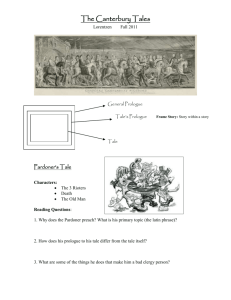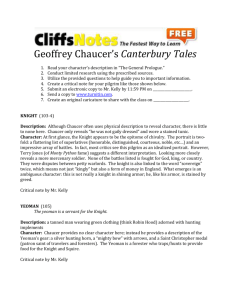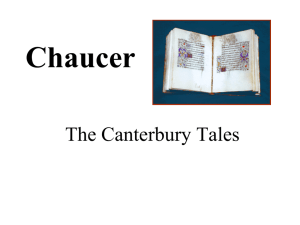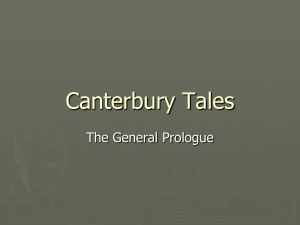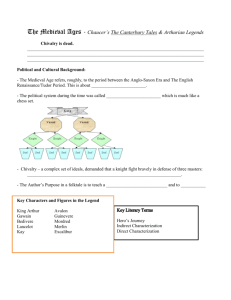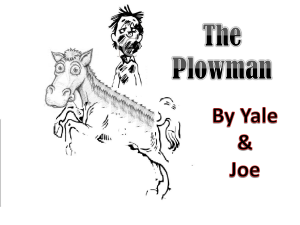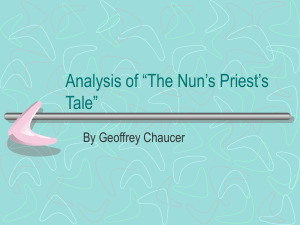The Wife of Bath`s Tale
advertisement
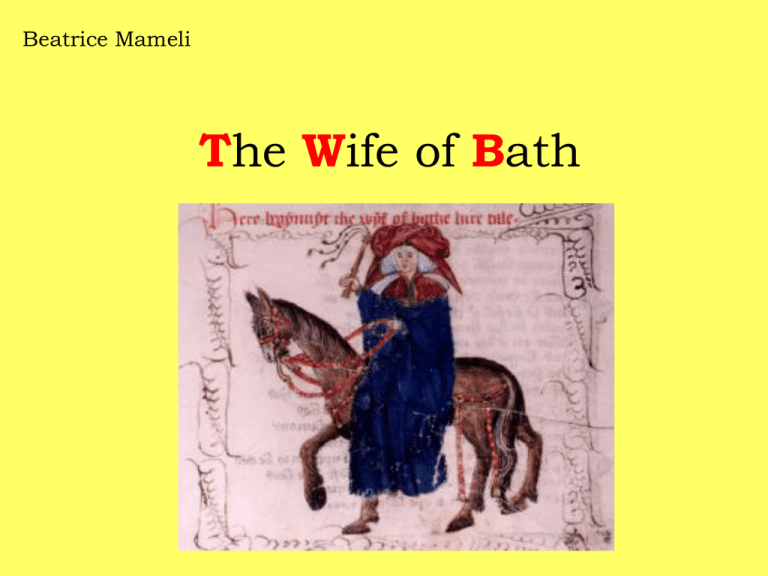
Beatrice Mameli The Wife of Bath We will be looking at: • The prologue -sources -Alisoun vs conduct literature • The Tale -the romance genre -analogues The Prologue (lines 1-8) She has had experience enough to be able to state that there always is much trouble in marriage. (line 13) She should have married only once because: - (line 11) Christ took part only to one wedding feast - (lines 15-19) he reproached a Samaritan for having had 5 husbands BUT: - (lines 23-25) nobody ever defined with certainty how many husbands a woman is allowed to have - ( line 28) God bade us “increase and multiply” - (lines 35-43) Solomon had more than one wife - (lines 55-56) Abraham, Jacob (lines 62-82) Virginity is only recommended because sexual intercourse is not explicitly forbidden. (lines 95-114) Chastity might be a good solution, but she is not interested (she does not want to reach perfection). (lines 115-137) defence of “procreation”. (lines 154-163; 313-314) She wants power over herself, her possessions, and her husband(s) (Lines 163-187) the Pardoner tries to interrupt her. (Lines 195-223) Her husbands: three were “good” (=old and rich). They loved her and she always had the upper hand. (lines 224-378) Accusing your husband (and your potential rivals) is a wise way to hold him under control. (lines 431-442) Men are more reasonable than women, therefore, in quarrels it is the man who should be patient. (lines 453-502) The fourth husband was a reveller and had a lover. She “was his Purgatory on Earth” for this. • (lines 457-479) One should drink and have fun while she is young. • (lines 503-825) The fifth husband is the worst but he is also the one she loves the most: he would not be easily subjugated, but eventually she tamed him. Prologue: the sources • http://www.luminarium.org/medli t/wifimg.htm Ellesmere Manuscript (first half 15th century) Huntington Library 41 glosses with literary references Prologue: the sources Model for Alison: La vieille (Roman de la rose) Antifeminist literature: Maybe Deschamps’s Miroir de Mariage (Chaucer probably got a copy in 1393; but it could also be a common source) Lamentations of Matheolus (Mathieu of Boulogne) Adversus Jovinianum (Saint Jerome) Walter Map’s Dissuasio Valerii ad Rufinum Philosophum ne uxorem ducat (in De Nugis Curialium 4.3-5) First Epistle to the Corinthians (Saint Paul) BOOK OF WIKKED WYVES: -Dissuasio Valerii ad Rufinum Philosophum ne uxorem ducat (De Nugis Curialium, 4.3) -Epistula adversus Jovinianum (Jerome) - De exortatione castitatis or De monogamia or De pudicitia (Tertullian) [-Crysippus: lost; probably the antifemminist writer mentioned by Jerome] - The De hegritudinibus mulierum or the De passionibus mulierum (Trotula of Salerno; 11th-12th centuries) - La vie et les Epistres de Pierres Aberlard et Heloys sa fame (trans. by Jean de Meun) - Bible: Prov. 31.10-31 - Ars Amatoria (Ovid) Women and conduct literature Conduct literature for women: Miroir des bonnes femmes (Franciscans; beginning 13th century) Livre pour l'enseignement de ses filles (Geoffrey De la Tour Landry; 14th century) They prescribed: -chastity -Sobriety -submission While Alisoun… • • • • • • • • She had “five husbands at church door” (line 6) She refuses chastity (line 46) She uses drinking metaphors (ex. lines 170-171) She wants power over herself, her possessions, and her husband(s) (lines 154-163; 313-314) She often travels alone. The fourth husband died when she was back from Jerusalem. (line 495) She can not keep secrets (lines 530-538) She’s over forty, but with a taste for young men. (Lines 600-602) She answers back (line 422) Narrators and Narration http://fr.wikipedia.org/wiki/F ichier:Johannes_gumpp.jpg Chaucer Alisoun Tale The Tale: Plot • (lines 857-881) King Arthur’s time and the Fairies • (lines 882-898) A knight rapes a girl. The king allows the Queen to decide whether he should live or die. • (lines 899-912) The Queen decides the knight will be set free only if he guesses what women most desire. The knight has a year and a day to find out. • (lines 913-944) All people he asks give different answers. • (lines 945-982) Ovid’s story of Midas’ ears. • (lines 983-1022) When nearly all hope is lost, he meets a group of fairy ladies in a wood. When he gets closer he realizes they are all gone but an old hag. The old hag promises she will give him the answer on condition that he grants her the first thing she asks. • (lines 1024-1045)He returns to court with the correct answer: women want sovereignty over their husbands and lovers. • (lines 1045- 1082) The old hag asks him to marry her as a reward for giving him the right answer. The knight has no choice but to take her as his wife. • (lines 1083-1218) On their first night together, the hag asks the knight what ails him. He answers that he is ashamed of having married someone so old and ugly and of such low condition. The hag replies defending virtue and gentleness of soul over the noble origins. • (lines 1219-1238) The hag allows the knight to choose whether he prefers a beautiful but unfaithful wife, or the old but trustworthy woman she is. He surrenders and gives her complete power over himself and their life together. • (lines 1239-1258) The hag becomes a beautiful young woman and they live happily ever after. The Romance • Hard to give a definition (no fixed length/ sometimes prose sometimes verse) • The story is generally felt as distant in time/space both for the audience and for the narrator • Segmentation of the narrative into episodes • Interlacing themes • Often belonging to cycles: Matter of Rome (Greek and Roman mythology)/Matter of France (Charlemagne, Roland)/Matter of Britain (Arthur) • Acceptance of a set of conventions The Romance: Standard Pattern Negative situation1 for the hero Quest 1 (divided into more episodes) Success/marriage Negative situation2 Quest2 Triumph Chaucer and Romance • Le Roman de la rose (translation; allegorical poem) • Troilus and Criseyde (difficulties in ending; irony) • The Knight’s Tale (contradictions of courtly love) • The Tale of Sir Topas (interrupted) The Tale and the Romance Genre Traditional: -Matter of Britain -Conventional pattern Innovative: - Arthurian time is worse than present time - knight/quest are not so “noble” after all - refusing clichés Analogues: the “loathly lady” Theme • Niall Noígíallach (“Niall of the Nine Hostages” Irish legend; Annála na gCeithre Máistrí ) • Perceval (Chrétien de Troyes) • The Wedding of Sir Gawain and Dame Ragnelle (15th century) Conclusions • Chaucer and auctorities: Troilus and Criseyde (V, 1772-1778) “Bysechyng every lady bright of hewe,/And every gentil womman, what she be,/That al be that Criseyde was untrewe,/That for that gilt she be nat wroth with me./Ye may hire gilt in other bokes se;/And gladlier I wol write, yif yow leste,/Penolopees trouthe and good Alceste” • Chaucer and women: Merchant’s Tale (lines 2311-2317) “I yeve it up! But sith I swoor myn ooth That I wolde graunten hym his sighte ageyn, My word shal stonde, I warne yow certeyn. I am a kyng, it sit me noght to lye." "And I," quod she, "a queene of Fayerye! Hir answere shal she have, I undertake.” Useful Bibliography • • • • • • • Boitani, Piero, Mann, Jill (eds.) The Cambridge Companion to Chaucer, Cambridge : Cambridge University Press, 2003. Benson, Larry D.(ed.), The Riverside Chaucer, Oxford: Oxford University Press, 2008. Brunetti, Giuseppe, Sui Racconti di Canterbury, Padova: Unipress. 1988. Correale, Robert M., Hamel, Mary (eds.), Sources and Analogues of the Canterbury Tales II, Woodbridge: D. S. Brewer, 2005. Harding, Wendy (ed.) Drama, narrative and Poetry in the Canterbury Tales, Toulouse: Presses Universitaires du Mirail, 2003. Johnston, Mark (ed.), Medieval Conduct Literature, An Anthology of Vernacular Guides to Behavious for Youths, with English Translations, Toronto: University of Toronto Press, 2009. Thompson, N.S., Chaucer, Boccaccio, and the Debate of Love, Oxford: Clarendon press, 1996. (http://www.youtube.com/watch?v=_XJCOmcKadQ&feature=related)

